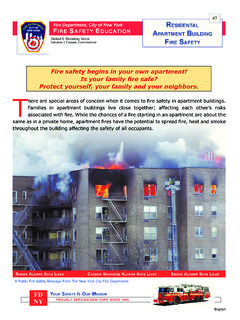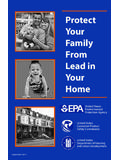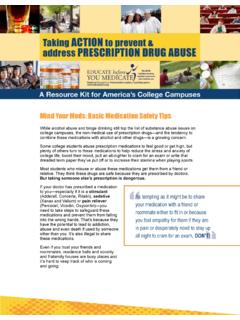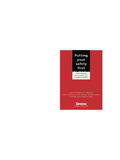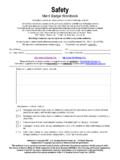Transcription of THIS FIRE SAFETY PLAN IS INTENDED TO HELP YOU AND THE ...
1 FIRE SAFETY PLANPART II FIRE EMERGENCY INFORMATIONBUILDINGADDRESS:_____THIS FIRE SAFETY PLAN IS INTENDED TO HELP YOU AND THE MEMBERS OFYOUR HOUSEHOLD PROTECT YOURSELVES IN THE EVENT OF FIRE. THISFIRE SAFETY PLAN CONTAINS: Basic fire prevention and fire preparedness measures that will reduce the risk offire and maximize your SAFETY in the event of a fire. Basic information about your building, including the type of construction, thedifferent ways of exiting the building, and the types of fire SAFETY systems it mayhave. Emergency fire SAFETY and evacuation instructions in the event of fire in TAKE THE TIME TO READ THIS FIRE SAFETY PLAN AND TO DISCUSSIT WITH THE MEMBERS OF your HOUSEHOLD.
2 FIRE PREVENTION,PREPAREDNESS, AND AWARENESS CAN SAVE your LIFE!IN THE EVENT OF A FIRE,CALL 911OR THE FIRE DEPARTMENT DISPATCHER, ATManhattan(212) 999-2222 Bronx(212) 999-3333 Brooklyn(718) 999-4444 Queens(718) 999-5555 Staten Island(718) 999-6666OR TRANSMIT AN ALARM FROMTHE NEAREST FIRE ALARM BOXBASIC FIRE PREVENTION AND FIRE PREPAREDNESS MEASUREST hese are fire SAFETY tips that everybody should follow:1. Every apartment should be equipped with at least one smoke detector. Check themperiodically to make sure they work. Most smoke detectors can be tested by pressing thetest button. Replace the batteries in the spring and fall when you move your clocksforward or back an hour, and whenever a smoke detector chirps to signal that its batteryis low.
3 The smoke detector should be replaced on a regular basis in accordance with themanufacturer s recommendation, but at least once every ten Carelessly handled or discarded cigarettes are the leading cause of fire deaths. Neversmoke in bed or when you are drowsy, and be especially careful when smoking on a sure that you completely extinguish every cigarette in an ashtray that is deep andwon t tip over. Never leave a lit or smoldering cigarette on Matches and lighters can be deadly in the hands of children. Store them out of reach ofchildren and teach them about the danger of Do not leave cooking unattended. Keep stove tops clean and free of items that can catchon fire.
4 Before you go to bed, check your kitchen to ensure that your oven is off and anycoffeepot or teapot is Never overload electrical outlets. Replace any electrical cord that is cracked or run extension cords under rugs. Use only power strips with Keep all doorways and windows leading to fire escapes free of obstructions, and report tothe owner any obstructions or accumulations of rubbish in the hallways, stairwells, fireescapes or other means of Install window gates only if it is absolutely necessary for security reasons. Install onlyapproved window gates. Do not install window gates with key locks. A delay in findingor using the key could cost lives.
5 Maintain the window gate s opening device so itoperates smoothly. Familiarize yourself and the members of your household with theoperation of the window Familiarize yourself and members of your household with the location of all stairwells,fire escapes and other means of With the members of your household, prepare an emergency escape route to use in theevent of a fire in the building. Choose a meeting place a safe distance from your buildingwhere you should all meet in case you get separated during a Exercise care in the use and placement of fresh cut decorative greens, such as Christmastrees and holiday wreaths.
6 If possible, keep them planted or in water. Do not place themin public hallways or where they might block egress from your apartment if they catch onfire. Keep them away from any flame, including fireplaces. Do not keep for extendedperiod of time; as they dry, decorative greens become easily INFORMATIONB uilding ConstructionIn a fire emergency, the decision to leave or to stay in your apartment will depend in part on thetype of building you are buildings built before 1968 are generally classified either as fireproof or non-fireproof. Residential buildings built in or after 1968 are generally classified either as3 combustible or non-combustible.
7 The type of building construction generally depends onthe size and height of the non-combustible or fireproof building is a building whose structural components (thesupporting elements of the building, such as steel or reinforced concrete beams and floors) areconstructed of materials that do not burn or are resistant to fire and therefore will not contributeto the spread of the fire. In such buildings, fires are more likely to be contained in the apartmentor space in which they start and less likely to spread inside the building walls to other apartmentsand floors. THIS DOES NOT MEAN THAT THE BUILDING IS IMMUNE TO FIRE.
8 Whilethe structural components of the building may not catch fire, all of the contents of the building(including furniture, carpeting, wood floors, decorations and personal belongings) may catch onfire and generate flame, heat and large amounts of smoke, which can travel throughout thebuilding, especially if apartment or stairwell doors are left combustible or non-fireproof building has structural components (such as wood) that willburn if exposed to fire and can contribute to the spread of the fire. In such buildings, the fire canspread inside the building walls to other apartments and floors, in addition to the flame, heat andsmoke that can be generated by the burning of the contents of the sure to check Part I (Building Information Section) of this fire SAFETY plan to see what type ofbuilding you are of EgressAll residential buildings have at least one means of egress (way of exiting the building), andmost have at least two.
9 There are several different types of egress:Interior Stairs: All buildings have stairs leading to the street level. These stairs may beenclosed or unenclosed. Unenclosed stairwells (stairs that are not separated from the hallwaysby walls and doors) do not prevent the spread of flame, heat and smoke. Since flame, heat andsmoke generally rise, unenclosed stairwells may not ensure safe egress in the event of a fire on alower floor. Enclosed stairs are more likely to permit safe egress from the building, if the doorsare kept closed. It is important to get familiar with the means of egress available in Stairs: Some buildings provide access to the apartments by means of stairs andcorridors that are outdoors.
10 The fact that they are outdoors and do not trap heat and smokeenhances their SAFETY in the event of a fire, provided that they are not Tower Stairs: These are generally enclosed stairwells in a tower separated fromthe building by air shafts open to the outside. The open air shafts allow heat and smoke toescape from the Escapes: Many older buildings are equipped with a fire escape on the outside of thebuilding, which is accessed through a window or balcony. Fire escapes are considered a secondary or alternative means of egress, and are to be used if the primary means of egress(stairwells) cannot be safely used to exit the building because they are obstructed by flame, heator : Most buildings have more than one exit.










